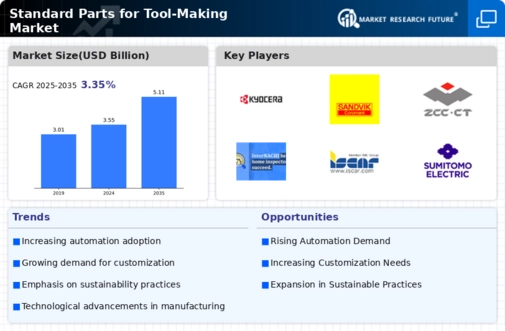Growing Investment in R&D
Growing investment in research and development (R&D) is a key driver of the Global Standard Parts for Tool-Making Market Industry. Companies are increasingly allocating resources to innovate and improve the quality and functionality of standard parts. This investment is crucial for developing advanced materials and manufacturing techniques that enhance product performance. For example, research initiatives focused on creating lightweight yet durable materials are gaining traction in industries such as aerospace and automotive. As R&D efforts intensify, the market is likely to benefit from the introduction of innovative standard parts that meet evolving industry demands, thereby fostering growth and competitiveness in the global landscape.
Market Growth Projections
The Global Standard Parts for Tool-Making Market Industry is projected to experience substantial growth over the next decade. With a market value anticipated to reach 3.55 USD Billion in 2024 and further expand to 5.11 USD Billion by 2035, the industry is poised for a robust trajectory. The compound annual growth rate (CAGR) of 3.36% from 2025 to 2035 indicates a steady increase in demand for standard parts across various sectors. This growth is driven by factors such as technological advancements, globalization, and the rising need for precision engineering. The market's expansion reflects the critical role of standard parts in supporting diverse manufacturing processes worldwide.
Globalization of Supply Chains
The globalization of supply chains significantly influences the Global Standard Parts for Tool-Making Market Industry. As companies expand their operations internationally, the demand for standardized components that can be seamlessly integrated into diverse manufacturing processes increases. This trend is particularly evident in industries such as electronics and machinery, where global collaboration is essential for maintaining competitiveness. The ability to source standard parts from various regions enhances operational efficiency and reduces costs. Consequently, the market is poised for growth, with estimates suggesting a market value of 5.11 USD Billion by 2035. This globalization trend underscores the importance of standardization in facilitating international trade and production.
Increased Focus on Sustainability
The Global Standard Parts for Tool-Making Market Industry is witnessing an increased focus on sustainability and environmentally friendly practices. Manufacturers are increasingly prioritizing the use of recyclable materials and energy-efficient production methods to meet regulatory requirements and consumer preferences. For instance, companies are adopting sustainable practices in the production of standard parts, which not only reduces environmental impact but also enhances brand reputation. This shift towards sustainability is likely to drive market growth as industries seek to align with global sustainability goals. As a result, the demand for eco-friendly standard parts is expected to rise, further contributing to the industry's expansion in the coming years.
Rising Demand for Precision Engineering
The Global Standard Parts for Tool-Making Market Industry experiences a notable surge in demand for precision engineering components. Industries such as automotive, aerospace, and electronics increasingly require high-quality standard parts to enhance manufacturing efficiency and product reliability. For instance, the automotive sector's shift towards electric vehicles necessitates precision components that meet stringent performance standards. This trend is expected to contribute to the market's growth, with projections indicating a market value of 3.55 USD Billion in 2024. As manufacturers adapt to these evolving requirements, the demand for standardized parts is likely to escalate, reinforcing the industry's position in global manufacturing.
Technological Advancements in Manufacturing
Technological advancements play a pivotal role in shaping the Global Standard Parts for Tool-Making Market Industry. Innovations such as additive manufacturing and automation are revolutionizing production processes, allowing for the rapid creation of complex components with reduced lead times. For example, the integration of 3D printing technology enables manufacturers to produce customized standard parts on demand, minimizing waste and optimizing resource utilization. As these technologies continue to evolve, they are expected to drive market growth, with a projected compound annual growth rate (CAGR) of 3.36% from 2025 to 2035. This growth reflects the industry's adaptability to technological changes and the increasing need for efficient manufacturing solutions.
























Leave a Comment